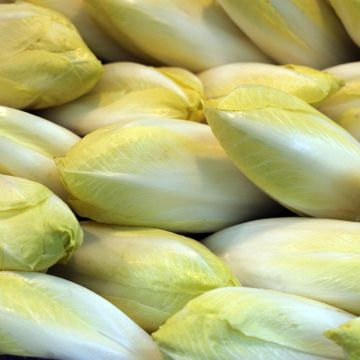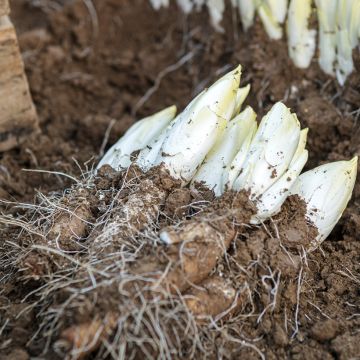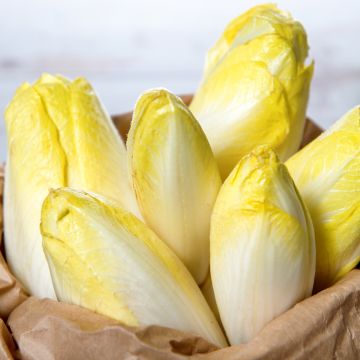

Endive Roots - Cichorium intybus
Endive Roots - Cichorium intybus
Cichorium intybus
Chicory, Common chicory, Blue sailors, Succory, Coffeeweed
This item cannot be shipped to the selected country
Delivery charge from €5.90
Delivery charge from €5.90
More information
Schedule delivery date,
and select date in basket
This plant carries a 6 months recovery warranty
More information
We guarantee the quality of our plants for a full growing cycle, and will replace at our expense any plant that fails to recover under normal climatic and planting conditions.
From €5.90 for pickup delivery and €6.90 for home delivery
Express home delivery from €8.90.
From €5.90 for pickup delivery and €6.90 for home delivery
Express home delivery from €8.90.
Description
The chicory, known as 'Witloof' or Belgian endive, is a winter vegetable to be consumed raw or cooked. The roots are forced to grow in darkness, either in trenches in the vegetable garden or crates of soil, in a cool and dark place. Harvest takes place from January to March.
The chicory develops, as a result of forcing, on a wild chicory root. Forcing involves cultivating the roots in darkness in order to blanch the leaves by depriving them of light. The roots are protected from light either in the vegetable garden by placing them in a trench or crates of soil placed in a dark room.
The chicory contains 95% water and is a light and easily digestible winter vegetable. It can be consumed raw in salads or cooked, in gratins, juices, braised, or accompanied by a béchamel sauce.
Harvesting: chicory is harvested from January to March, as needed. Remove the protection and break off the chicory by hand at the neck. Immediately cover them with opaque paper to prevent them from turning green, which makes them bitter. Leave the roots in the ground to hope for a harvest of smaller chicory heads a few weeks later.
Storage: chicory should not be exposed to light after harvesting, it should be protected from it. Leave them in the ground if you don't need them immediately.
The gardener's tip: for forcing in crates, tilt the crate on its side to fill it; this will optimise the adhesion between the soil and the roots. Alternate layers of soil/sand and the roots placed flat, then straighten the crate.
Report an error about the product description
Harvest
Plant habit
Foliage
Other Chicory
Planting and care
Forcing endives can be done in trenches in the vegetable garden or in a cool, dark place. The darkness must be total. The leaves will have been cut 1 or 2 cm (0 or 1in) above the collar. The roots should be the same height; trim the ends of the roots if necessary.
In the vegetable garden, dig trenches 30 cm (12in) deep and 1 meter (3 feet) wide. Place the endive roots vertically, tightly packed together. Cover them with a mixture of sand and fine soil. Water generously so that the soil penetrates between the roots. Add 20 cm (8in) of soil and 10 cm (4in) of straw or leaves for insulation. Finish by placing a waterproof cover (metal sheet, black plastic, frame...).
In crates, line the bottom with a mixture of potting soil and sand. Install the roots vertically and tightly packed together. Cover them with potting soil and sand up to the collar. Water generously so that this mixture penetrates between the roots. Close the crate (with a garbage bag, for example) to ensure total darkness. Water regularly. The crates will be placed in a room protected from light (cellar, pantry...). The temperature should be between 10 and 20°C (50 and 68°F) and will affect the duration of the forcing. The higher the temperature, the faster the forcing (allow three weeks at 20°C (68°F)).
Cultivation
Care
Intended location
-
, onOrder confirmed
Reply from on Promesse de fleurs
Haven't found what you were looking for?
Hardiness is the lowest winter temperature a plant can endure without suffering serious damage or even dying. However, hardiness is affected by location (a sheltered area, such as a patio), protection (winter cover) and soil type (hardiness is improved by well-drained soil).

Photo Sharing Terms & Conditions
In order to encourage gardeners to interact and share their experiences, Promesse de fleurs offers various media enabling content to be uploaded onto its Site - in particular via the ‘Photo sharing’ module.
The User agrees to refrain from:
- Posting any content that is illegal, prejudicial, insulting, racist, inciteful to hatred, revisionist, contrary to public decency, that infringes on privacy or on the privacy rights of third parties, in particular the publicity rights of persons and goods, intellectual property rights, or the right to privacy.
- Submitting content on behalf of a third party;
- Impersonate the identity of a third party and/or publish any personal information about a third party;
In general, the User undertakes to refrain from any unethical behaviour.
All Content (in particular text, comments, files, images, photos, videos, creative works, etc.), which may be subject to property or intellectual property rights, image or other private rights, shall remain the property of the User, subject to the limited rights granted by the terms of the licence granted by Promesse de fleurs as stated below. Users are at liberty to publish or not to publish such Content on the Site, notably via the ‘Photo Sharing’ facility, and accept that this Content shall be made public and freely accessible, notably on the Internet.
Users further acknowledge, undertake to have ,and guarantee that they hold all necessary rights and permissions to publish such material on the Site, in particular with regard to the legislation in force pertaining to any privacy, property, intellectual property, image, or contractual rights, or rights of any other nature. By publishing such Content on the Site, Users acknowledge accepting full liability as publishers of the Content within the meaning of the law, and grant Promesse de fleurs, free of charge, an inclusive, worldwide licence for the said Content for the entire duration of its publication, including all reproduction, representation, up/downloading, displaying, performing, transmission, and storage rights.
Users also grant permission for their name to be linked to the Content and accept that this link may not always be made available.
By engaging in posting material, Users consent to their Content becoming automatically accessible on the Internet, in particular on other sites and/or blogs and/or web pages of the Promesse de fleurs site, including in particular social pages and the Promesse de fleurs catalogue.
Users may secure the removal of entrusted content free of charge by issuing a simple request via our contact form.
The flowering period indicated on our website applies to countries and regions located in USDA zone 8 (France, the United Kingdom, Ireland, the Netherlands, etc.)
It will vary according to where you live:
- In zones 9 to 10 (Italy, Spain, Greece, etc.), flowering will occur about 2 to 4 weeks earlier.
- In zones 6 to 7 (Germany, Poland, Slovenia, and lower mountainous regions), flowering will be delayed by 2 to 3 weeks.
- In zone 5 (Central Europe, Scandinavia), blooming will be delayed by 3 to 5 weeks.
In temperate climates, pruning of spring-flowering shrubs (forsythia, spireas, etc.) should be done just after flowering.
Pruning of summer-flowering shrubs (Indian Lilac, Perovskia, etc.) can be done in winter or spring.
In cold regions as well as with frost-sensitive plants, avoid pruning too early when severe frosts may still occur.
The planting period indicated on our website applies to countries and regions located in USDA zone 8 (France, United Kingdom, Ireland, Netherlands).
It will vary according to where you live:
- In Mediterranean zones (Marseille, Madrid, Milan, etc.), autumn and winter are the best planting periods.
- In continental zones (Strasbourg, Munich, Vienna, etc.), delay planting by 2 to 3 weeks in spring and bring it forward by 2 to 4 weeks in autumn.
- In mountainous regions (the Alps, Pyrenees, Carpathians, etc.), it is best to plant in late spring (May-June) or late summer (August-September).
The harvesting period indicated on our website applies to countries and regions in USDA zone 8 (France, England, Ireland, the Netherlands).
In colder areas (Scandinavia, Poland, Austria...) fruit and vegetable harvests are likely to be delayed by 3-4 weeks.
In warmer areas (Italy, Spain, Greece, etc.), harvesting will probably take place earlier, depending on weather conditions.
The sowing periods indicated on our website apply to countries and regions within USDA Zone 8 (France, UK, Ireland, Netherlands).
In colder areas (Scandinavia, Poland, Austria...), delay any outdoor sowing by 3-4 weeks, or sow under glass.
In warmer climes (Italy, Spain, Greece, etc.), bring outdoor sowing forward by a few weeks.








































